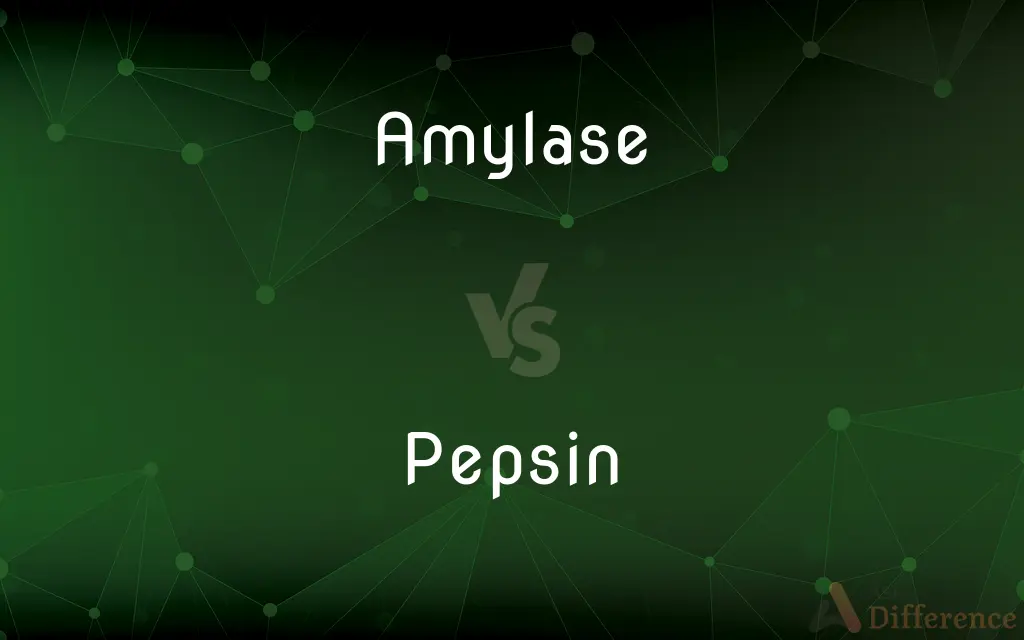Amylase vs. Pepsin — What's the Difference?
By Urooj Arif & Fiza Rafique — Updated on April 8, 2024
Amylase breaks down starches into sugars in the mouth and small intestine, while pepsin digests proteins into peptides in the stomach.

Difference Between Amylase and Pepsin
Table of Contents
ADVERTISEMENT
Key Differences
Amylase is an enzyme that catalyzes the hydrolysis of starch into simpler sugars like maltose and dextrin, beginning the process of carbohydrate digestion. It is secreted by the salivary glands in the mouth and by the pancreas into the small intestine. This enzyme plays a crucial role in the first step of carbohydrate digestion, making complex carbohydrates more accessible for further breakdown and absorption. On the other hand, pepsin is a proteolytic enzyme that breaks down proteins into smaller peptides. It is produced in the stomach lining from its inactive form, pepsinogen, which is activated by stomach acid. Pepsin works optimally in the highly acidic environment of the stomach, initiating the protein digestion process.
The action of amylase is essential for the digestion of carbohydrates, which are a primary energy source for the body. It operates in a neutral or slightly alkaline pH, reflecting its activity locations in the mouth and small intestine. Whereas, pepsin's activity is critical for protein digestion, breaking down dietary proteins into peptides that can be further broken down by other enzymes in the small intestine. Its optimal function in acidic conditions is a unique characteristic that distinguishes it from many other digestive enzymes.
While both enzymes are pivotal for the digestive process, their specificity to substrates—amylase to starches and pepsin to proteins—highlights the complexity of the human digestive system, designed to extract a wide range of nutrients from food. The initial action of these enzymes on food is complemented by other enzymes throughout the digestive tract, ensuring that nutrients are broken down into their simplest forms for absorption.
In terms of production and secretion, amylase is found in saliva and pancreatic juice, indicating its role in both the preliminary and latter stages of food digestion. In contrast, pepsin is uniquely produced in the stomach, emphasizing the stomach’s role in protein digestion. This distinction also points to the adaptive nature of the digestive system, capable of initiating the breakdown of specific nutrients at different points in the digestive process.
Understanding the roles of amylase and pepsin provides insight into the digestive system's efficiency and specialization. Both enzymes are essential, but they function in distinct phases of digestion and are adapted to specific types of food molecules, showcasing the specialized and coordinated approach of the human body to nutrition and health.
ADVERTISEMENT
Comparison Chart
Substrate
Starches
Proteins
Product
Sugars (maltose, dextrin)
Peptides
PH Optimum
Neutral to slightly alkaline
Highly acidic
Location
Mouth & small intestine
Stomach
Role
Initiates carbohydrate digestion
Initiates protein digestion
Secretion Source
Salivary glands and pancreas
Stomach lining
Compare with Definitions
Amylase
Produces simpler sugars from starches.
Amylase breaks down pasta into sugar molecules.
Pepsin
Proteolytic enzyme for proteins.
Pepsin is crucial for digesting meat proteins.
Amylase
Functions in neutral/slightly alkaline pH.
Amylase requires a less acidic environment than pepsin.
Pepsin
Produced in the stomach lining.
Pepsin begins the protein digestion process soon after eating.
Amylase
Enzyme for carbohydrate breakdown.
Amylase starts the digestion of bread as soon as it's chewed.
Pepsin
Active in the stomach's acidic environment.
Pepsinogen becomes active pepsin in stomach acid.
Amylase
Secreted by salivary glands and pancreas.
Salivary amylase is why starchy food starts to taste sweet.
Pepsin
Breaks proteins into smaller peptides.
Pepsin turns the proteins in eggs into peptides.
Amylase
Operates in mouth and small intestine.
Amylase activity continues from saliva to the pancreas.
Pepsin
Optimal in highly acidic pH.
The stomach’s acidity is essential for pepsin's activity.
Amylase
An amylase () is an enzyme that catalyses the hydrolysis of starch (Latin amylum) into sugars. Amylase is present in the saliva of humans and some other mammals, where it begins the chemical process of digestion.
Pepsin
Pepsin is an endopeptidase that breaks down proteins into smaller peptides. It is produced in the gastric chief cells of the stomach lining and is one of the main digestive enzymes in the digestive systems of humans and many other animals, where it helps digest the proteins in food.
Amylase
Any of a group of enzymes that catalyze the hydrolysis of starch to sugars. In humans, amylases are produced in the salivary glands and the pancreas.
Pepsin
A digestive enzyme found in gastric juice that catalyzes the breakdown of protein to peptides.
Amylase
(enzyme) Any of a class of digestive enzymes, present in saliva and also contributed to the gut by the exocrine pancreas, that break down complex carbohydrates such as starch into simpler sugars such as glucose.
Egg yolk amylase
Pepsin
A substance containing pepsin, obtained from the stomachs of hogs and calves and used as a digestive aid.
Amylase
Any of a group of proteins found in saliva and pancreatic juice and parts of plants; help convert starch to sugar
Pepsin
(enzyme) A digestive enzyme that chemically digests, or breaks down, proteins into shorter chains of amino acids.
Pepsin
A proteolytic enzyme (MW 34,500) contained in the secretory glands of the stomach. In the gastric juice it is united with dilute hydrochloric acid (0.2 per cent, approximately) and the two together constitute the active portion of the digestive fluid. It degrades proteins to proteoses and peptides, and is notable for having a very low pH optimum for its activity. It is the active agent in the gastric juice of all animals.
Pepsin
An enzyme produced in the stomach that splits proteins into peptones
Common Curiosities
Can amylase break down proteins?
No, amylase is specific to carbohydrates and cannot break down proteins.
What is the main function of amylase?
Amylase's main function is to catalyze the breakdown of starches into simpler sugars during digestion.
Why is pepsin not active until it reaches the stomach?
Pepsin is produced as an inactive precursor, pepsinogen, which is activated by the acidic environment of the stomach to prevent it from digesting proteins in body tissues.
How does the pH affect the activity of amylase and pepsin?
Amylase works best in a neutral to slightly alkaline pH, while pepsin requires a highly acidic environment to be active.
What happens if amylase or pepsin is not produced adequately?
Inadequate production of amylase or pepsin can lead to difficulties in digesting carbohydrates or proteins, respectively, affecting nutrient absorption.
How are amylase and pepsin levels tested?
Levels can be tested through blood tests, measuring enzyme activity, and indicating potential issues with the pancreas or stomach.
Can the activities of amylase and pepsin overlap?
While their activities don’t overlap due to different pH optima and substrates, they are part of the sequential process of digestion.
Where does pepsin function in the digestive system?
Pepsin functions in the stomach, initiating the digestion of proteins into peptides.
Is pepsin active outside the stomach?
Pepsin is most active in the stomach's acidic environment and becomes less effective as the pH increases beyond the stomach.
How do amylase and pepsin deficiencies affect health?
Deficiencies can lead to malabsorption issues, with symptoms like malnutrition, weight loss, and digestive discomfort.
Are there any inhibitors for amylase and pepsin?
Yes, certain substances can inhibit their activities, such as plant compounds for amylase and specific drugs that reduce stomach acidity for pepsin.
How does cooking affect the substrates of amylase and pepsin?
Cooking can denature proteins, making them easier for pepsin to break down, and gelatinize starches, making them more accessible to amylase.
What is the significance of amylase and pepsin in nutrition?
They are crucial for the digestive process, ensuring that nutrients from carbohydrates and proteins are available for the body's use.
Can amylase and pepsin be taken as supplements?
Yes, they are available as supplements to aid digestion, particularly for people with enzyme deficiencies.
What role does the pH play in the activation of pepsin from pepsinogen?
The acidic pH of the stomach converts pepsinogen to its active form, pepsin, enabling it to digest proteins.
Share Your Discovery

Previous Comparison
Airtel vs. Jio
Next Comparison
Poppy vs. AnemoneAuthor Spotlight
Written by
Urooj ArifUrooj is a skilled content writer at Ask Difference, known for her exceptional ability to simplify complex topics into engaging and informative content. With a passion for research and a flair for clear, concise writing, she consistently delivers articles that resonate with our diverse audience.
Co-written by
Fiza RafiqueFiza Rafique is a skilled content writer at AskDifference.com, where she meticulously refines and enhances written pieces. Drawing from her vast editorial expertise, Fiza ensures clarity, accuracy, and precision in every article. Passionate about language, she continually seeks to elevate the quality of content for readers worldwide.
















































